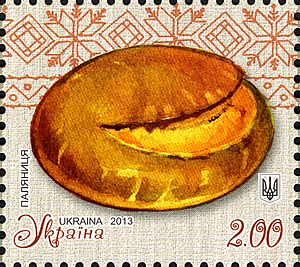Palianytsia facts for kids

Palyanytsya depicted on a Ukrainian postage stamp
|
|
| Type | Bread |
|---|---|
| Place of origin | Ukraine |
| Main ingredients | Flour |
Palyanytsya (Ukrainian: паляниця) is a special type of Ukrainian bread. It's usually baked in a home oven and made mostly from wheat flour. This round, yeast bread often has a unique semi-circular cut on its top. It's not just food; it's also an important part of Ukrainian culture and history.
Contents
The Story Behind the Name
The word "Palyanytsya" comes from the Ukrainian word palyty. This means "to burn" or "to smoke." This name might have come about because the bread's crust can sometimes get a little burned during baking.
Some people also believe the name comes from the Polans. They were an old East Slavic tribe who traditionally made a similar bread. Another idea is that the word is linked to an ancient Greek word, pelanos. This word described round cakes offered to gods long ago.
How to Bake Palyanytsya
Traditional palyanytsya is made from yeast dough. Here's a simplified look at how it was often prepared:
- First, hops were boiled in a pot.
- This hop water was then poured into a special bowl called a makitra.
- Sifted wheat flour was added to the makitra.
- The dough was kneaded well, covered, and left to cool down.
- After cooling, yeast or sourdough was mixed into the dough.
- The dough was then placed in an unheated oven overnight to rise.
- In the morning, the risen dough was kneaded again with more wheat flour.
- Warm water and salt were added during this kneading.
- The dough was kneaded until it no longer stuck to the baker's hands.
- Finally, the dough was divided into pieces and shaped.
- Each loaf was placed on a wooden shovel, often sprinkled with flour or placed on a steamed cabbage leaf.
- Before baking, a cut was made in the bread. This helps it rise even more in the oven.
In the past, bakeries in the Soviet Union also made a standard "Ukrainian palyanytsya." These loaves usually weighed between 750 grams and 1 kilogram.
What Palyanytsya Means
Palyanytsya, like bread in general, holds deep meaning in Ukrainian culture. It often stands for happiness and good fortune. It can also represent kindness, a warm welcome, and safety. Some people even see palyanytsya as a symbol of the sun.
There are also some old beliefs about eating palyanytsya:
- It's thought to be unlucky to eat a piece of palyanytsya right after someone else. People believed it would take away their happiness.
- Leaving a piece of bread uneaten was also considered bad luck.
- Eating bread behind another person's back was thought to "eat" their strength.
A Special Word Test
The word "palyanytsya" is used as a special test in the Ukrainian language. This kind of test is called a shibboleth. It helps to tell if someone is a native Ukrainian speaker or not.
Why is it a test? Because the Ukrainian sounds in "palyanytsya" are hard for non-native speakers to say correctly. For example, Russian speakers often say the Ukrainian "и" sound like "i" and the Ukrainian "я" sound like "a." So, "palyanytsia" might sound more like "palianitsa" to them. Another common mistake is with the "ц" (ts) sound. In Russian, this sound is never softened, but in Ukrainian, it can be.
During the 2022 Russian invasion of Ukraine, this word became very important. It was used to help identify Russian soldiers or saboteurs who might pretend to be Ukrainian. If they couldn't say "palyanytsya" correctly, it showed they were likely not native Ukrainian speakers.

